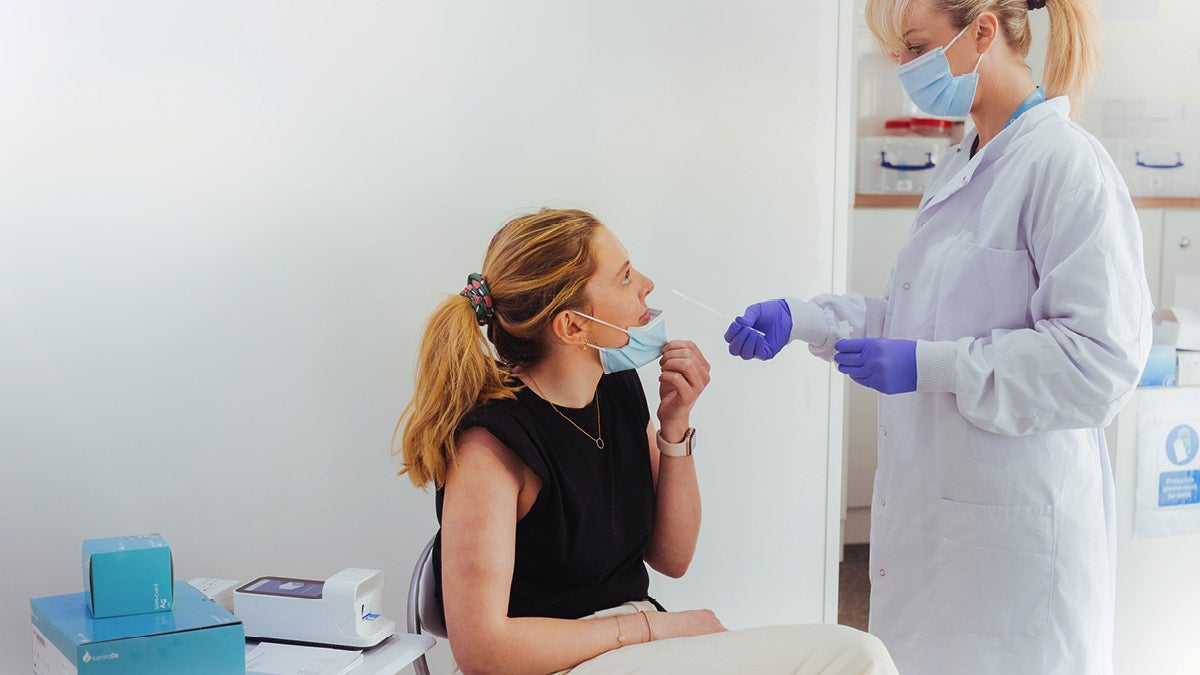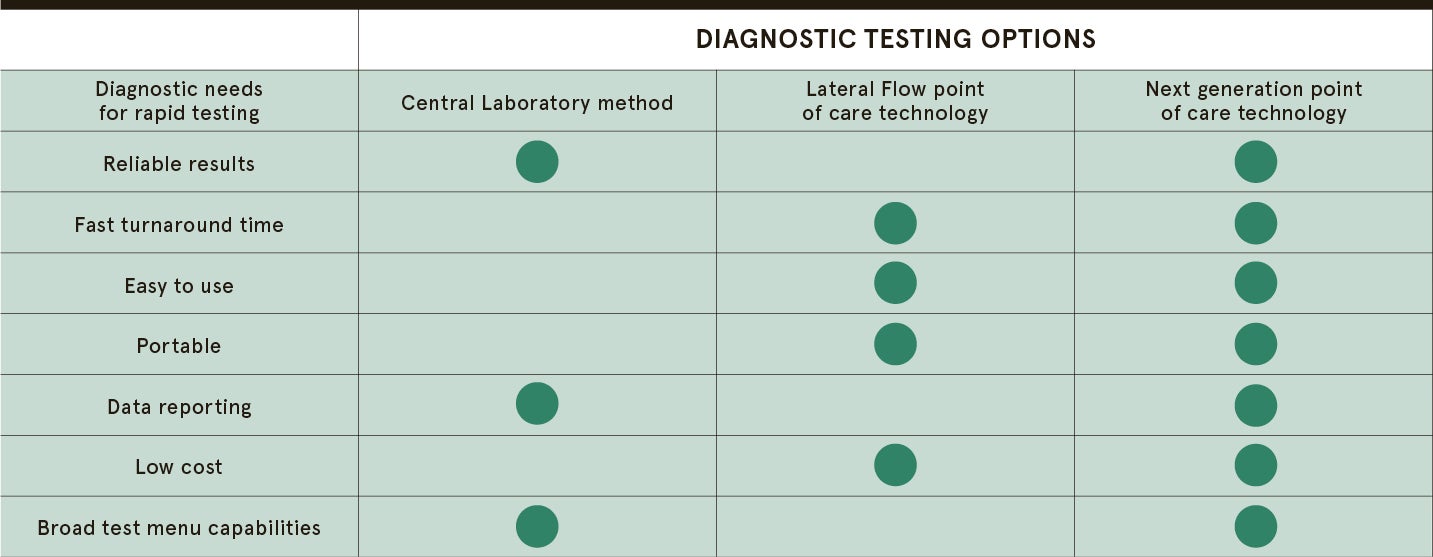
Screening, diagnostic testing and monitoring are the foundation of healthcare decisions. A patient can’t be treated effectively until a diagnosis is made. Testing for the coronavirus has been one of the toughest global challenges and it has demonstrated how rapid, reliable diagnostics can benefit individual patients and influence economic recovery.
Previously, testing performance and speed were at odds, but because of recent technological advancements, it’s now possible to deliver both. Next-generation point of care testing (POCT), different from traditional lateral flow tests, has proven its ability to deliver highly sensitive COVID tests results within 15 minutes.
Accurate, fast testing has allowed children to attend schools, helped the NHS rapidly triage patients attending A&E into COVID-positive and COVID-negative treatment areas, and enabled workers to resume employment safely where testing was needed. This is a paradigm shift
for healthcare.
While diagnostic testing is an important part of patient care, it has not been a focus for many health systems: the NHS spends less than 1 per cent of its total budget on diagnostics, although they influence nearly 70 per cent of clinical decisions.
Diagnostic testing had been considered a lengthy and laborious process. In order to give test samples, patients often had multiple touchpoints, sometimes in different buildings, then waited days or weeks for the results and further GP appointments.
Lack of reliable point of care technology hindered the adoption of testing that better served patients, but COVID-19 demonstrated the need for testing and heightened the importance of receiving accurate and immediate results, and the importance of connectivity to report the data.

“POCT has come of age in the pandemic because of its ability to deliver accurate results while you wait, compared to four or five days’ delay for results,” says professor Chris Price, emeritus professor in clinical biochemistry at Queen Mary, University of London. “POCT delivers results more quickly and reduces the need to send a patient to the hospital for an outpatient appointment.”
Professor Price’s recent commentary in the BMJ Innovations Journal - Will COVID-19 be the coming of age of point-of-care testing? - highlights how technological developments have meant rapid test analytical performance now match laboratory devices.
UK-based LumiraDx has developed a next-generation point of care diagnostic platform and tests that are transforming care, including its rapid test for COVID-19, which was rolled out across UK healthcare settings and high street pharmacies such as Boots.
“The severity of the pandemic highlighted the need for increased levels of innovation and we worked hard to deliver high performance. Now, healthcare, governments and the public are realising what rapid testing can bring.” says David Walton, LumiraDx chief commercial officer.
“Fast and high-performing tests were a help during COVID-19 and are still a vital part of moving forward. It’s about all of us: getting students back to school, being able to go to work safely, visiting friends and family in different countries. It is helping us live our lives to the fullest and allowing economies to reopen.”
The barriers to rapid testing have been falling as next-generation technology provides accurate results that can be trusted and delivered economically.
Rapid testing is effective in a broad range of settings, such as remote communities and for employers, and for a variety of conditions such as hepatitis Professor Price adds. A study of rapid testing in diabetic patients found improved glycaemic control and patient satisfaction along with significant reductions in patient visits, phlebotomy needs and administration costs.
While rapid testing has clearly been a critical tool in diagnosing COVID-19, it has also made it possible for patients with chronic disease to receive rapid and ongoing monitoring of their illness in safe environments during the pandemic.
Beacon Primary Care, in Skelmersdale, Lancashire, organised a drive-through INR (international normalised ratio) testing facility for patients at risk of thrombosis, a potentially life-threatening condition if unchecked. Patients simply extended their arms for a pinprick of blood that was analysed by LumiraDx technology within minutes, with dosing instructions delivered the same day by email or text. INRStar clinical decision support software was used to manage anticoagulation treatment.
Professor Sir Bruce Keogh, former medical director of NHS England and who sits on the LumiraDx Board of Directors says, “Point of care technologies have clearly come of age and now offer much more convenient, reliable and cheaper diagnostic testing. They offer an exciting and essential contribution to the inevitable post COVID redesign of healthcare. Their use is now a no-brainer.”
Future developments
Moving testing from huge, central laboratories to rapid, portable devices has been a pivotal change in medical technology and LumiraDx has been at the forefront of innovation since it was founded in 2014.
LumiraDx addresses the current limitations of legacy point of care systems by bringing lab-comparable performance to the point of care in minutes, on a single instrument with a low cost of ownership, making healthcare decisions affordable and accessible.
The LumiraDx Platform currently runs four microfluidic tests, in a device the size of a house brick, and is developing more than 30 tests addressing cardiometabolic disease, diabetes, coagulation and infectious disease.
“Making rapid testing accessible is about empowering people to take more control of their lives as well as making lab-quality testing widely available at pharmacies, schools, work and the home,” says Pooja Pathak, LumiraDx vice president of platform strategy.
She adds “The pandemic is a leapfrog moment, demonstrating the vital importance of rapid testing today and suggesting the potential of new developments tomorrow. The public wants medical technology to improve their lives in meaningful ways. We created high-performance testing that is faster, more convenient and cheaper than traditional diagnostics, because it will improve people’s health and wellbeing.”
For more information please visit lumiradx.com/uk-en
Promoted by Lumiradx

Screening, diagnostic testing and monitoring are the foundation of healthcare decisions. A patient can’t be treated effectively until a diagnosis is made. Testing for the coronavirus has been one of the toughest global challenges and it has demonstrated how rapid, reliable diagnostics can benefit individual patients and influence economic recovery.
Previously, testing performance and speed were at odds, but because of recent technological advancements, it’s now possible to deliver both. Next-generation point of care testing (POCT), different from traditional lateral flow tests, has proven its ability to deliver highly sensitive COVID tests results within 15 minutes.
Accurate, fast testing has allowed children to attend schools, helped the NHS rapidly triage patients attending A&E into COVID-positive and COVID-negative treatment areas, and enabled workers to resume employment safely where testing was needed. This is a paradigm shift
for healthcare.

